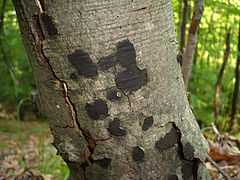Biscogniauxia nummularia
| Biscogniauxia nummularia | |
|---|---|
 | |
| Scientific classification | |
| Kingdom: | Fungi |
| Phylum: | Ascomycota |
| Class: | Sordariomycetes |
| Subclass: | Xylariomycetidae |
| Order: | Xylariales |
| Family: | Xylariaceae |
| Genus: | Biscogniauxia |
| Species: | B. nummularia |
| Binomial name | |
| Biscogniauxia nummularia (Bull.) Kuntze | |
| Synonyms | |
|
Biscogniauxia bulliardii (Tul. & C. Tul.) Kuntze | |
Biscogniauxia nummularia is a plant pathogen in the Xylariaceae family, known as the Beech Tarcrust.[1] The Latin 'nummus' meaning a coin, applied as the encrustations are often rounded and coin-like.
Views of the Beech Tarcrust
-
Detail of the Tarcrust's structure.
-
Beech Tarcrust growth.
-
Encrustations on beech bark
The fruiting body forms a thick and shiny black crust, on Beech (Fagus) bark and is found at all times of the year. It is not edible.[1] Young specimens are covered by a light brown outer layer. The spores are black to dark brown. B. nummularia is a common fungus specific for Fagus, and has been recorded from all parts of Europe and Russia, following the extensive distribution of its host tree. [2]
B. nummularia as a primary pathogen
The decline of European beech (Fagus sylvatica) in Sicily and Calabria (Italy) has been linked to B. nummularia and experiments have suggested that this Ascomycete plays a primary pathogenic role under certain environmental conditions.[3] It typically causes strip-canker and general wood decay.[4]
References
Notes
Sources
- Phillips, Roger (2006). Mushrooms. London : Pan MacMillan. ISBN 0-330-44237-6


